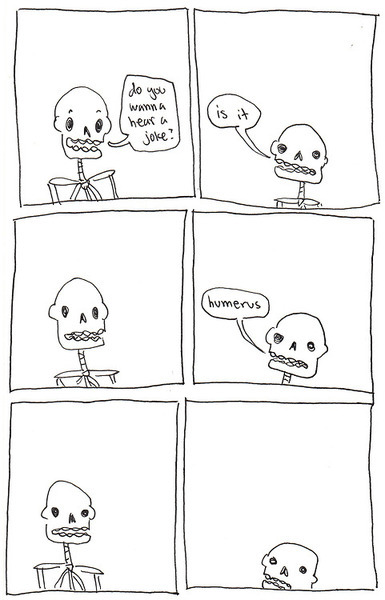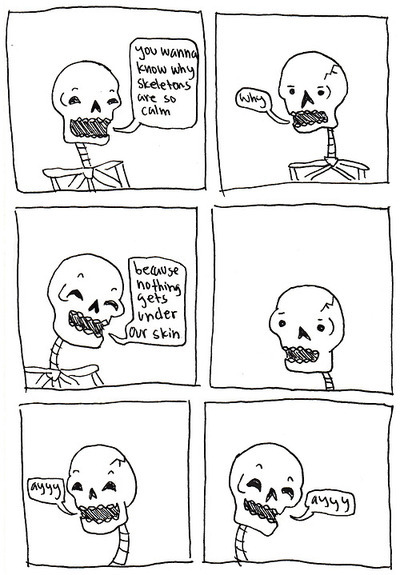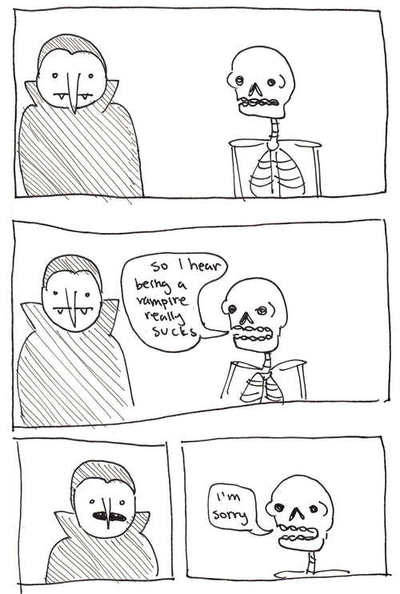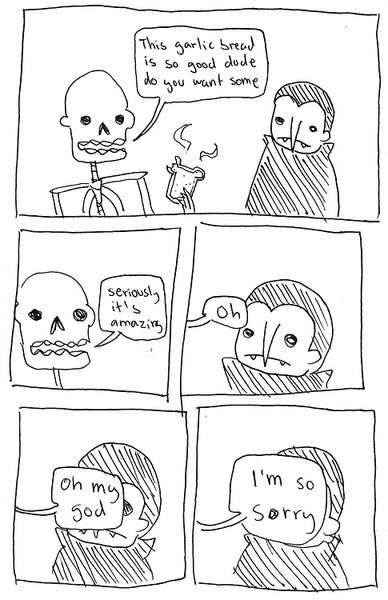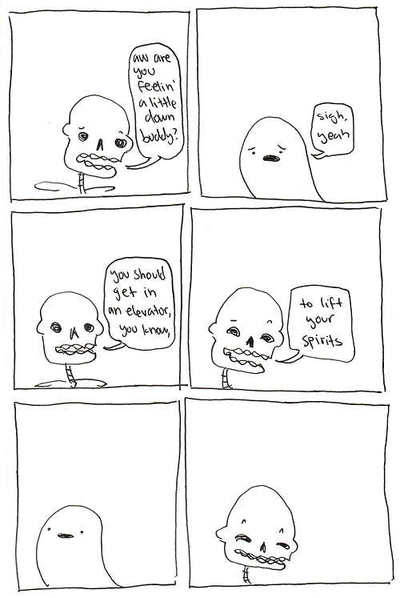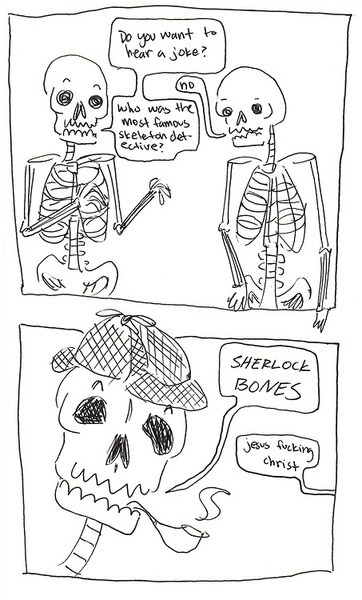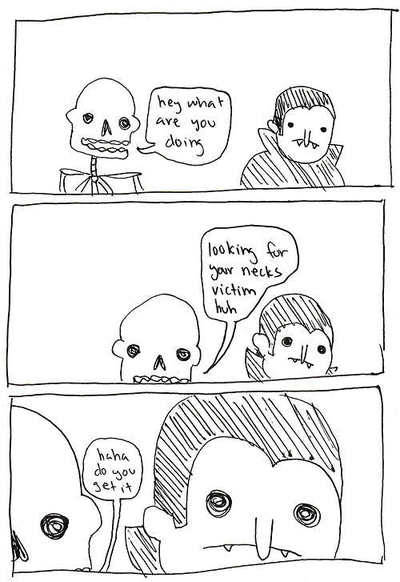Hola y bienvenidos a mi blog. Me llamo Chris. Aqui puedes leer todo sobre lo que pienso de las lecciones, lecturas asignadas, y otras preguntas de esta clase como son presentados cada semana.
Don't wanna be here? Send us removal request.
Photo

Dancing with your friends makes you feel part of something bigger than yourself, gives you a merged sense of you and them, strengthens your relationships, builds trust, and raises your pain tolerance. Source
7K notes
·
View notes
Text
Week 15
Week 15 – Final Thoughts After 15 weeks of talking about design, where do you see the future of design? Please give at least three examples of projects or disciplines that will effect your career choices.
0 notes
Text
Week 14
Week 14 – Cultivating Design Awareness Within this 7 day span of time, you will make daily observations (posts) of design as you go through the days of the week. As you now know, design is around you all day, every day. Document your observations daily with any of the media options available within the Tumblr platform. It must be original content and not re-blogs. If it is an observation of design on the web, take a screen shot and share a link along with a written rationale as to why it caught your attention.
0 notes
Text
Week 13
Week 13 – New Media Please expand on the term “digital aesthetic” as defined by the reading and lectures provided in class. Talk about the shift in how and what we design using digital technology.
0 notes
Text
Week 12
Week 12 – Social Design Discuss and write about what you think “Social Design” might mean. Do you think there is a difference between 1) ”Design for Social Good” and 2) “Design for Social Impact?” Site 4 case studies that are examples of what each might mean.
In its essence, I think this differentiation between designing for social impact vs. designing for social good is accredited to the idea of designing for profit (design influenced largely/solely by capitalism and measured in impact by cost of design/service and the amount of revenue it produces) vs. designing for the progression or betterment of specific aspects of the environment by which society is dictated throughout the world--in which case its ‘effectiveness’ is measured by the amount of social reform/progress is ignited as a result of the product/service that is being implemented.
0 notes
Text
Week 11
Week 11 – Communication Design Your reading this week references the “Citizen Designer - the do good pledge.” What does that mean? Would you take the pledge and might this change your outlook on your profession?
I’ve always had a bit of an eye out for the subtle and/or full inclusion of social justice elements and topics--specifically, at UW-Madison, being one of the campus-known ‘flyer-makers’, I’ve had the opportunity to work on a nice amount of different social justice projects in the context of school projects, flyers for different campus organizations (both free-of-charge, as well as for-profit), and a couple of personal projects as well...all good experiences overall I think...

A flyer for AHANA (a health org. on campus)

A flyer I created for a youth fishing summer program myself and a classmate of mine headed as part of an extended opportunity from a social/environmental justice class I’d taken.

A more simple typographical layout I composed for the advertising of a campus-mate’s film-project he’d debuted on campus (1 of 5 typographical ‘ads’ for this project)

One of my very many generic design-layouts for various different cultural orgs. on campus...

Design for a project UW Madison’s PEOPLE Program (shouts to the PEOPLE Scholars! whoot! whoot!) was putting together in Milwaukee for Summer ‘12 I think.

More of an ‘art-project’ I suppose...but a semi-started, semi-finished graphic I’d manipulated...nonetheless some aspect of social-justice/societal-critique is still apparent/implied...

Flyer for one of my frat’s annual campus parties...ohh the memories..hahaa

Banner (one of many, many images and design elements) imagery for the Kappa Rho chapter site of my fraternity (shouts to Phi Beta Sigma and Kappa Rho! . GOMAB and all that good stuff....) that I’d designed and implemented all by me-self (one of my first more major web-design projects...fun stuff)---sad note: not after the site and accompanying blog component were ready for live-use, the campus monopolized the way the orgs. on campus used their campus-given host-site internet space into one generic system with dry dispersal pages of information and zero chances of personalization/customization of the sites....but el experience tho !!!! (soy muy optimisto si no lo pudieras ver)


More sigma stuff....some campus org. projects were more worth-while than the others...


Class Project: “Design liek a famous graphic designer’ project (more social justice stuff...)
So yeah, I’ve got a pretty good history with integrating aspects of social justice/progress into my design projects...some were much more complex in their full integration than others (one non-featured project was part of a presentation, etc.)...all were much more rewarding that way--and much easier to have an impact on the observer as well when successful.
However, I will add that, in regards to the actuality of this really catching on as a ‘thing’ in the more ‘global’ perspective of design is a bit more farfetched than he may make it seem--given the way that capitalism and most capitalist corps. (in this ‘still-infantil-era’ of human civilization) work, and also given that design is still very largely consumer-driven profession, I think it would be a particularly difficult task to do as he suggests....although I believe it to be a truly feasible implementation throughout the designers in the design profession, I don’t think this is something that design within itself can start and it be as successful as he envisions it--I think it would take some sort of social-reform-movement-of-the-people’s-consciousness kind of deal first/simultaneously with the design’s input.
1 note
·
View note
Text
Week 10
Week 10 – Communication Design Please expand upon what David Berman means by the “world is our common design project.” Give at least three examples and show illustrations, describing each.
With our designs, we can choose to merely impact the world/society by mostly capitalizing off of its imperfections and shortcomings, or to instead, actually cater to it’s well-being and development, and exploit the grand benefits of the more “eco-friendly/socio-progressive” approach to design in our societies.
0 notes
Text
Week 9
Week 9 – Design & Cultural Context Based on your readings and lectures so far, research Brooks Stevens, how does Milwaukee fit into the history of Industrial Design? Why did Brook Stevens choose to stay in Milwaukee?
Mr. Stevens was a founder of the industrial design business in the 1930's, along with men like Raymond Loewy, who designed the Coca-Cola logo and John Vassos, who modernized the exterior appearance of radios.
Unlike them, he resisted the temptation to move to New York, keeping his business, Brooks Stevens Design Associates, in the Milwaukee area.
"He did everything from cigarette lighters to pavement rippers," said Gary Wolfe, curator of the Brooks Stevens Gallery of Industrial Design at the Milwaukee Institute of Art and Design. "His specialty was to make products more user-friendly. He was best at understanding how products were meant to function and modifying them so the customer could use them more easily."
He designed the corporate logo for Miller beer and persuaded the company to use clear bottles, rather than the traditional brown, to go with its advertising slogan "the champagne of bottled beer.
Mr. Stevens also designed the last prototypes for Studebaker, including a station wagon with a sliding roof to permit hauling tall objects. The cars were never produced, but the prototypes wound up in the Brooks Stevens Car Museum in Mequon, Wis., along with the 75 antique cars he had collected. In 1958, he designed the "Weinermobile," with a giant hot dog replica on the top, for the Oscar Mayer Company.
He attended Cornell University from 1929 to 1933, studying architecture, but he returned to Milwaukee without graduating because the Depression had put a stop to most building. At the suggestion of his father, who was a vice president of the Cutler-Hammer Company, a producer of industrial equipment in Milwaukee, he opened an office in 1934 as a design consultant. One of his first projects was to design a line of electrical controls for Cutler-Hammer and a corporate logo for the company.
In 1944, along with Raymond Loewy and eight other men, he helped form the Industrial Designers Society of America, which today has thousands of members.
From: http://www.nytimes.com/1995/01/07/obituaries/brooks-stevens-83-giant-in-industrial-design.html
Stevens, Brooks: known as "the Seer that made Milwaukee Famous", US designer and coach-builder...
From: http://www.coachbuilt.com/des/s/stevens/stevens.htm
Born on June 7, 1911, in Milwaukee, Wisconsin, Industrial Designer Brooks Stevens was known for an array of innovations that spanned 60 years.
Stevens sphere of influence spread quickly until 1952 when estimated annual retail sales of the products designed by him reached one billion dollars. He was one of the last of a generation of product-design pioneers whose creations paved the way for the everyday gadgetry that people now take for granted.
Mr. Stevens continued to teach industrial design at the Milwaukee Institute of Art & Design until his death in 1995. The rich legacy of industrial design continues today by Brooks' sons as Brooks Stevens Design in Wisconsin.
1966 Master Design Award for the Milwaukeematic Automatic Machining Center for Kearney & Trecker Corp.
From: http://www.excaliburclassics.com/bio.html
Brooks Stevens Inc., the firm that defined industrial design in the golden age of Milwaukee industry, may be returning to its urban roots.
From: http://www.jsonline.com/business/industrial-design-firm-brooks-stevens-seeks-cool-urban-location-b9987754z1-222442141.html
0 notes
Text
Week 8
Week 8 – Architecture/Interior Design Look around you in Milwaukee. Pick two buildings/areas, one contemporary and one historic and discuss their significance, the emotion and feelings that each generate. Post 5 images, and architectural drawings of each with citations. Compare and contrast how they effect the built environment.
1) Milwaukee Art Museum & Abstract Sculpture Area: Adventure & Discovery
ABOUT HISTORY N STUFF:...
Milwaukee Art Museum & Abstract Orange Sculpture Visual Comparison:
Milwaukee Art Museum and Abstract Orange Sculpture 1
Milwaukee Art Museum and Abstract Orange Sculpture 2
Milwaukee Art Museum and Abstract Orange Sculpture 3
Milwaukee Art Museum and Abstract Orange Sculpture 4
Abstract Orange Sculpture 1
Abstract Orange Sculpture 2
Abstract Orange Sculpture Detail
Milwaukee Art Museum 1
Milwaukee Art Museum 2
2) Allen-Bradley Clock Tower: History, Order, & Structure
ABOUT HISTORY N STUFF:...
Allen-Bradley Clock Tower Images:
Allen-Bradley Clock Tower 1
Allen-Bradley Clock Tower 2
Allen-Bradley Clock Tower 3
Allen-Bradley Clock Tower 4
Allen-Bradley Clock Tower 5
Allen-Bradley Clock Tower 6
Allen-Bradley Clock Tower 7
Milwaukee Art Museum + Orange Sculpture & Allen-Bradley Clock Tower Comparison:
stuff stuff stuff...
1 note
·
View note
Text
Week 7
Week 7 –Design Research Write out two ways in which design can impact the world in which we live. Provide three examples of corporate CEO’s who have embraced “Design Thinking” and research methodologies. Mention their names and discuss the shift in corporate culture as a result of their leadership.
1) Appearance and Functionality of an object/product.
2) Design in the context of the planning and the implementation of organizational structures that goes into dealing with the (customer) service aspects of marketing and design in the product-consumer industry.
Corporate CEO examples:
1. Indra Nooyi and PepsiCo
design thinking, which Nooyi has increasingly brought into the company to improve the user experience, and help differentiate all of PepsiCo’s offerings, from soda to chips, and beyond.
It’s been a big culture change for Pepsi
forget me as the CEO of the company. As a mom who shops, who does grocery shopping, it was getting harder and harder to really differentiate what were the great products, what were the products that really spoke to me.
we had to rethink our whole innovation process.
Research: I went to my direct reports, and gave them each an empty photo album, and a camera. And I said, I want you to take a picture of anything that you think is good design.
They didn’t even know what design was.
within the company, people talked about design as package.
they were thinking about it strictly from a lipstick on a pig, if you want to call it, as opposed to redesigning the pig itself.
That’s when I realized we needed to bring in a designer into the company.
And Mauro Porcini showed up on the radar as somebody who’d done this at 3M. So we brought Mauro here, and talked to him about what our vision was.
a product that has great design is something that you have a real reaction to.
It’s a product you want to engage with in the future as opposed to, yeah, I bought it , and I ate it.
We’re not talking about making a more advanced food service machine. We’re talking about a fundamentally different interaction of the consumer to the machine.
“So, if you look at the Pepsi Spire, think of this gigantic iPad sitting on this most futuristic machine, which actually talks to you and invites you to that machine to want to interact with it. It attracts what you do, so that in future when you come back and you swipe your ID, it will tell you what flavor combinations you did the last time. It will actually suggest other new flavors to you.”
“The products that show up on the machine make you want to drink right off the screen. So it’s beautiful shots of the product. And when you add a lime, and a cranberry, it actually shows how the lime and cranberry are adding, so you actually experience that addition of the flavors, as opposed to two buttons you hit, and out comes your beverage.”
“User experience was not something that ever was part of our lexicon. User experience in terms of crunch and taste was part of our lexicon in the past, not in terms of rethink the shape, rethink the packaging form function itself.”
Now, Nooyi says, “design” has a voice in nearly every important decision that the company makes.
“Perhaps that was the single biggest change in the company. The culture changed to say, the strength of the company was our decentralized company. The weakness of the company was a decentralized company. The extremely decentralized company worked when the whole world was just growing, and life was peachy keen.It doesn’t work when digital media makes news from one place, transfers to another. So you’ve got to make sure the company does everything in a coordinated way.”
Source: https://hbr.org/ideacast/2015/08/pepsico-ceo-indra-nooyi-on-design-thinking.html
2. Steve Jobs and the Apple
CEOs and managers must know Design Thinking to do their jobs.
Design Thinking is the new Management Methodology.
Innovation is no longer just about new technology per se. It is about new models of organization. Design is no longer just about form anymore but is a method of thinking that can let you to see around corners. And the high tech breakthroughs that do count today are not about speed and performance but about collaboration, conversation and co-creation.
The iTunes explosion was the result of a lot of people at Apple working hard, not to mention the MP3 players that came before, and a visionary leader in Steve Jobs that understood the significance of putting it all together. That’s the key: its not a CEO that can design, but a CEO that can weave together diverse threads of understanding to figure out what’s next.
one thing that Steve Jobs does really, amazingly well is tell stories. His commencement address at Stanford is a great example of this. He knows how to appeal to both your head and heart. And of course, he uses this uncanny ability to help sell the designs and strategies he believes in.
From: http://www.businessweek.com/innovate/NussbaumOnDesign/archives/2007/06/ceos_must_be_de.html
3. Vishal Sikka and Infosys (Indian consulting firm)
nine months into his new job, he’s making a concerted effort to change the culture and introduce design thinking.
thinking beyond the boundaries of the defined process to look for something new
Making Large Cultural Shifts
The company handles many different tasks, and one thing that bothered him was that people only seemed to work to the specifications of the task. In other words, they only did what they were told to do and nothing more. This lack of creativity and unwillingness to try new things without permission bothered Sikka.
This is particularly relevant because he sees a future in which many of the missions his company has been hired to undertake will become automated and won’t require a room full of people. That means for his company to stay relevant, employees need to learn to think on their feet, be creative and come up with questions and solutions that are outside the abilities of an algorithm.
Changing The Company Mindset
At the same time, he saw this troubling lack of initiative. He needed to figure out how to give permission and encourage his employees, who had been trained to do what they were told, to become creative thinkers and change things on the fly.
He said even though this sounds like a contradiction — creativity versus following orders — he soon realized it wasn’t. “There is no contradiction. The following of orders, the lack of proactivity is very different from the lack of motivation. It is as if you don’t know it’s OK to think. Nobody told you can bring your creativity to bear,” he said.
This became his cultural imperative for his first year, to change that mindset and set his employees free to bring their brains and creativity to work every day.
In Sikka’s view, in the not-too-distant future, systems will do much of the problem solving and people will need to engage in “problem finding”. He believes what separates entrepreneurs from everyone else is this ability to find problems nobody else noticed. The taxi system was seemingly working fine until Uber found a more creative way of attacking that problem.
Software can show you sales are down or which customers are buying more or less, but it can’t attack or identify a systemic problem. That takes human intervention.
“You need to think about this in a different way and use design thinking to break out of how we have thought in the past. Think beyond what they are able to do and wrap their heads around next generation problems. Turn on the education machine in a massive way to teach design thinking,” he said.
And that’s what he did.
He started by bringing his executive team to Stanford for a week where they participated in classes designed to teach this very ideal. Next came the education team, who then created a course and began putting students through it.
“You cannot watch a video. You have to do something. Construction is better than instruction,” he said.
So far, 30,000 employees have taken the one-day innovation workshop.
From: http://techcrunch.com/2015/05/16/infosys-ceo-on-mission-to-transform-his-company-into-design-thinkers/
1 note
·
View note
Text
Week 6
Week 6 – Industrial Design Please post observations, photographs, drawings or film clips of products/services that have changed or will change the way we live in the future
I think the future changes of the way we live in relation to new technologies will generally follow a genre/pattern of being “disconnectedly-connected.” This entails a return to the ‘hands-free’ perspective of dealing/interacting with life in combination with the continual progressive use of the developing technologies and all of their benefits of efficiency, enhancements of human capabilities, user accessibility, etc.
The following are examples of what I perceive to be an upcoming trend in product design/services:
1) Touch/Gestural/Sensory technologies.
A Touchscreen
2) Drone technology (Easily-Portable Drone Cameras!)
Nixie: The wearable and flying drone camera
3) Land/Water Hover (board) technologies.
A 2015 Model of a Hoverboard
0 notes
Text
Week 5
Week 5 – Design Thinking Comment on what Tim Brown describes as the value of “Design Thinking.” Pull at least three examples from your readings on design systems and processes that are the result of human centered design research methods that have lead to innovative products or services that you see or use on a daily basis. Please provide images as well as citations for your work.
Brown, in his book “Change by Design,” describes ‘design thinking’ as an essentially human-centered exploratory process based on a system of overlapping spaces (consisting of Inspiration, Ideation, and and Implementation) (77) used to “share processes, encourage the collective ownership of ideas, and enable teams to learn from one another” (79). Design thinking is a willing embrace of constraints based on the framework of the three overlapping criteria of successful ideas: Feasibility, Viability, and Desirability (88-89).
Basically it means looking at every inch and aspect of what it takes to create/design a new product (from brainstorming, modeling, and on through to actual production and market-integration) from the perspective of ‘design;’ it’s expanding the flexibility of the term ‘design’ by also incorporating (or rather implying the inclusion of) the fundamental aspects of basic business organizational structuring and regular ol’ planning. So really, design thinking is the combination of the closely knit (in deifiniton as in practice) tasks of design, planning, and organizational structuring.
Examples of design thinking put to use:
1. Shimano + IDEO -- used a human-centered exploration (as opposed to the usual technological approach) of problem/solutions to design a new “coasting bike;” a bike designed to be reminiscent of the typical childhood ‘openly-explorative’ bike-riding-experience for the ‘casual/non-sporty cycler’ (with a full bike-riding campaign and in-store retailing strategies to match). Their slogan was “Chill. Explore. Dwadle. Lollygag. First one there’s a rotten egg” (73-74).
The 'Coasting' Experience
The 'Coasting' Bicycle Design
2. Nintendo Wii -- focused on a human-experience-centered approach to video game design industry (as opposed to the more tech-approach of relying on more sophisticated graphics and more expensive consoles) and created a more immersive experience by using the new technology of gestural control (90). Their design-thinking solution allowed for less focus on graphics, a lower costing console, and ultimately better margins on the product. Brown describes it as a perfect balance of desirability, feasibility, and viability (91).
Kid actively playing the Wii
Nintendo Wii Console Design
3. Google + Specialized “Innovate or Die Pedal-Powered Machine Contest” competition -- With the already-set goal of simply using bicycle technology to change the world, the winning team of this competition used the constraints of the competition (technology, budget, and deadline) as the primary motivation behind the entire progress of their design/model/build process. Their design process focused on exploring human needs (as opposed to the typical reliance on amount/duration of funds and the search for indefinitely extending the life of the research project) in relation to how they went about identifying a pressing issue, exploring a variety of alternative solutions, and building a working prototype. Their final product, The “Aquaduct” was a mobile, human-powered tricycle designed to filter drinking water while transporting it; traveling the world to help promote clean water innovation.
The 'Aquaduct' Pedal-Powered Machine Design
The 'Aquaduct' and Winning Design Team Members
0 notes
Text
Week 4
Week 4 – Found Object & Understanding the Visual Put away your phone and go for a walk. Go out into your world. See what possible objects you come across or encounter. Anything that you think possesses an element of design. It can be from nature or manufactured by people. Document your objects with a photo and written commentary or a video with audio commentary. Please summarize your observations as well as draw comparisons to other objects that are perhaps similar in how they are utilized or designed. Site at least 3 examples
*Photos courtesy of google images.
Design Observation 1
UW Milwaukee "Welcome" Brdige
Pros
Campus Landmark; UWM Banner
Provides quick access to other building; less pedestrians using street = traffic doesn't have to stop as frequently
Emphasizes the "main-area-ness" of that part of campus near the Union
Cons
Slippery in winter
Comparison
This bridge is very similar to the bridge on the UW Madison which reflects it in purpose as a sort of landmark for the campus, convenient building access and less frequent traffic stops for pedestrians, and also in how it's in close proximity to the campus' main union.
Design Observation 2
Beats by Dr. Dre Solo HD Headphones Sealed - Dark Blue
Pros
Very euphonic; sounds/instruments evenly distributed across and throughout left/right headphone channels
Blue!
Mobile compatibility: detachable cord w/volume + track seeking controls; small carry-around zip-up bag for headphones + cord; headphones retract/fold down to travel-size for carry-bag fitting purposes
Cons
Big/bigger than ear-buds; more difficult to transport/carry around
Not made for classroom-discretion-music-listening
Expensive
Comparison
Although not as portable, these over-the-head style headphones are much more powerful, controlled, and euphonic than a brand of ear-bud headphones called Skullcandy. I still enjoy my Skullcandy's for outside in public use though just becuase they're much more mobile-friendly.
Design Observation 3
"Change By Design" by Tim Brown - Book Cover
Pros
Clean
Concise
Informative/Straight to the point
Cons
Kind of boring; lacks movement; not very innovative design
Comparison
Other design books seem to exemplify a certain amount of organic elements in addition to/ in conjunction with/ on top of its already established and well-geometrically-strcutured, grid-based, foundational design layer.
1 note
·
View note
Text
Week 3
Week 3 – History of Design Post 10 drawings, photos and notes on design observations you see in the world around you since the beginning of this semester and comment how you see the future value of design.
Design Observation 1
Milwaukee 6th Street Viaduct
Design Observation 2
James Groppi Unity Bridge/Milwaukee 16th Street Viaduct
Design Observation 3
James Groppi Unity Bridge Plaque Design
Design Observation 4
UW-Milwaukee Maryland Street "Welcome" Bridge
Design Observation 5
Old Washington Park Milwaukee County Zoo: Park Design
Design Observation 6
Milwaukee North Point Lighthouse
Design Observation 7
Miller Park/ Brewers Stadium
Design Observation 8
Milwaukee Art Museum
Design Observation 9
'The Box Car': Scion XB 2006 | Industrial Design
Design Observation 10
Windows 10 Operating System | OS Design/Development
I don’t think design will be valued any more or less than it already is now. I think its value is already pretty much established and that it will only expand within itself (as it has been doing). Design may have its occasional peaks of interest and demand for new working designs with the coming of new technologies; however, the value of design as a (root) societal element won’t necessarily change in the times to come, in my opinion.
1 note
·
View note
Text
Week 2
Week 2 – Design in Context and History After reading Heskett, “Design a Very Short Introduction,” how does Heskett define design? Can you give me a few examples? Please refer to your reading for historical elements from the modern design movement. Expand on what you found to be the most significant concept from this weeks reading.
According to Heskett, Design is a very arbitrary term specific to the human race and vital to the very essence of our existence. It is a core capacity which allows us to shape the world in which we are surrounded in a way unlike any other living organism on the planet. Put in his own words, Heskett defines design in two different scopes--one being to take the term as it stands alone, and the other considering design in a historical sense:
1) “Design, stripped to its essence, can be defined as the human capacity to shape and make our environment in ways without precedent in nature, to serve our needs and give meaning to our lives.” (p. 5)
2) “The history of design, however, can be described more appropriately as a process of layering, in which new developments are added over time to what already exists. This layering, moreover, is not just a process of accumulation or aggregation, but a dynamic interaction in which each new stage changes the role, significance, and function of what survives.” (p. 6-7)
Heskett expands further on this second scope of design historically in the second chapter; he mentions the design of the human hand and how, throughout history, its capacity has been altered, extended, modified, and improved upon with the creation and help of new tools. For example, a stick or a clam shell may have been a bit more helpful in digging--a function already capable of being carried with one’s bare hands alone. Just the same, serving as another example, would a garden hoe be an improvement from a stick, shell, or even a cupped hand in carrying out specific desired activities; or even how a canoe is a bit of an adaptation of swimming. With these and other examples, Heskett successfully communicates the argument that design, over time, is not simply something capable of replacing the old, but in supplementing it as well. “The natural world provided a diverse source of available, pre-existing materials and models, full of potential for adaptation to the solution of problems.” (p. 9).
One of the more significant concepts covered in this weeks readings is the amount of emphasis Heskett puts into the idea behind the power of the brain as a “mind tool” and how it can be viewed as the main influence and source of design capability.
1 note
·
View note
Text
Week 1
Week 1 – About you Personalize your blog -be proud to share it and tell us a little more about yourself. Why did you take this class and what is your interest in design? Do you have any relevant experience? What inspires you? Post an image that reflects your inspiration.
I think I did these out of order--but here’s my post for this topic..
I chose to revise my personal bio sheet/assignment one and submit it here. The overall design wasn’t structured to fit its grid layout as much as it should’ve been. In addition to fitting the design to its grid, I’ve also nudged around some bodies of text to make more room at the top header area of the page and to give the layout as a whole a more structured feel; I’ve also made adjustments in regards to choice of typeface families and styles.
Finally, in the header area, I enlarged the personal photo, then reduced the text size of the header text and centered it to a horizontal middle line in alignment with the personal photo, which shares the other half of the header portion of the page.
There’s also now more of a visible trail of negative space with a bit of some playful and guiding elements to it in the way that the white space just spills into the center image from the header region, wraps itself around the center image, and then flows off into the bottom right-hand region of the sheet (which leads the observer directly to the short description of the center-photo and then at the very bottom they find the footer information).
These revisions, I think, really bring the assignment together more as a design-study-centered project.
Revised
Original
1 note
·
View note
